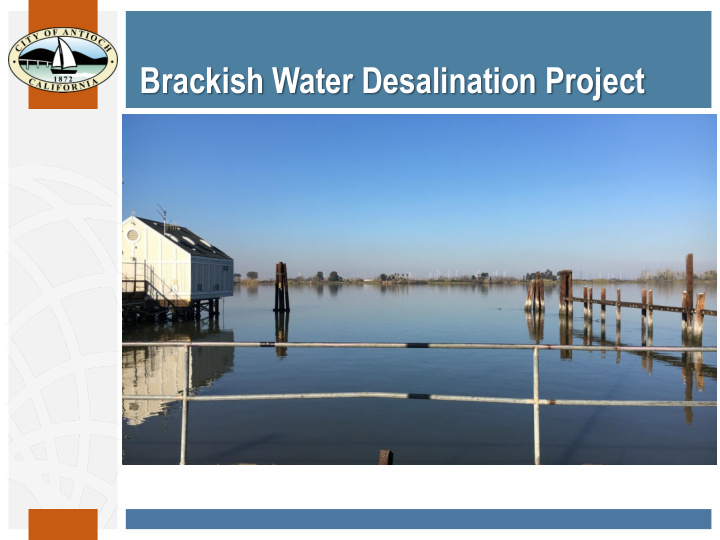



Brackish Water Desalination Project
Agenda ▪ Project background and objectives ▪ Project overview ▪ Accomplishments to date ▪ Funding ▪ Schedule
City water supply ▪ The City pumps, treats and distributes raw water from the San Joaquin River utilizing its pre-1914 water rights. ▪ The City purchases water from Contra Costa Water District when salinity is too high at its river intake.
Value of City’s water rights is being eroded ▪ Estimated value of City water rights: $70-$100M ▪ Changes in Delta water management: WaterFix ▪ Cumulative impacts of other projects degrading water quality in Western Delta – CCWD settlement on WaterFix – Freeport – Development in San Joaquin Valley, etc. ▪ Climate change: Increasing frequency of droughts
Increasing salinity in Western Delta forces City to stop using the river earlier in year ▪ In typical non-drought years, ▪ In drought years, the City must 40% of the City’s supply switch to CCWD supply earlier comes from the San Joaquin ▪ As little as 25% of the City’s River supply may come from the San Joaquin River
5 years ago the City began investigating brackish water project opportunities ▪ California in the middle of a 5 year drought ▪ Protect water quality and reliability against droughts ▪ Restore and maintain the value of the City’s water rights ▪ City needed to find ways to mitigate for WaterFix
Brackish water desalination is cost-effective ▪ Tidal Delta water ~50 times less salty than seawater ▪ One third the cost of seawater desalination ▪ Current cost of Antioch finished water – $1600/AF (CCWD raw water charge + treatment costs) ▪ Estimated water cost brackish water facility – $1,200/AF to $1,500/AF (including amortized capital costs)
Project overview ▪ Treat 8 MGD of brackish water to produce 6 MGD finished water – Could be as much as 16 MGD for a regional plant ▪ New river intake with state-of-the-art fish screens (incorporates existing CIP project) ▪ Desalination facility at existing Antioch WTP site ▪ Discharge brine at Delta Diablo existing outfall
Brackish Water Project makes cost-effective use of existing facilities N
Conceptual site plan at Antioch WTP
Desalination facility utilizes reverse osmosis membranes that are housed inside pressure vessels supported on racks
Pressure is applied to water passing through the RO membranes to “filter out” salts • Produces high-quality finished water called permeate • (Brine) stream is discharged to the wastewater plant
Environmental and economic benefits ▪ Improvements at the City’s intake would reduce its impact on the river ▪ State-of-the-art fish screens and variable speed pumping provide net environmental fish benefits ▪ New pumps will allow operational flexibility/efficiency in the timing and rate at which water is diverted ▪ The more reliable a community’s water supply, the better the prospects for industrial and commercial growth (jobs)
Accomplishments to date ▪ Received $1M in State financing for planning effort ▪ Completed EIR ▪ Awarded $10M grant from DWR – Funding Agreement underway ▪ Submitted $53M State low-interest loan application – Approval pending ▪ Developed project concepts and budgets ▪ Evaluated alternative ways to deliver project ▪ Continuing to pursue outside funding
Project schedule ▪ Complete preliminary design and permitting in late 2019 ▪ Secure low-interest loan and select design-build team in early 2020 ▪ Project online in early 2022
Project website Visit the Antioch Brackish Water Desal Project website for additional information and project updates. http://www.antiochbrackishdesal.com/
Recommend
More recommend